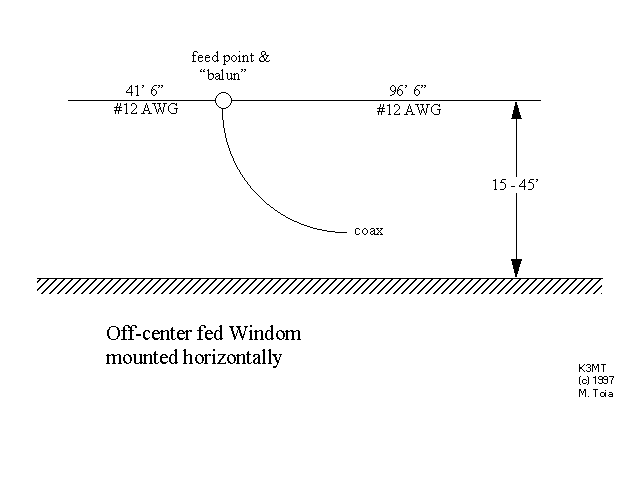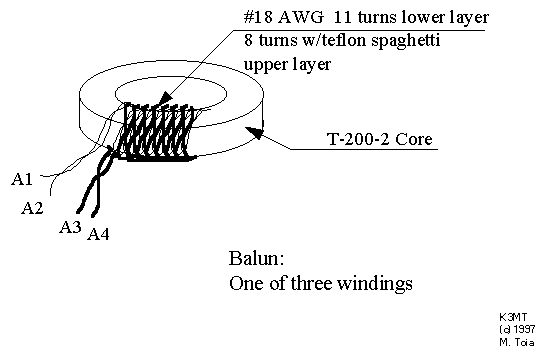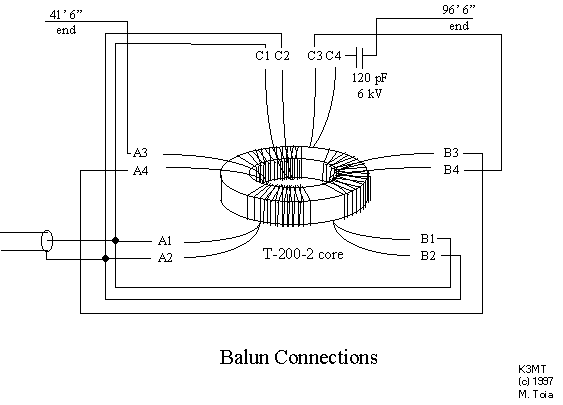
K3MT
and daughter KF4LGR
present . . .
(Authors' note - we now market a revised version of this
antenna that covers all HF bands except
30 meters, and covers 30 meters with use of an antenna tuner.
e-mail us for details.)
Now, how was a Windom antenna developed? It began with a
center-fed, half-wave dipole.
This antenna also works fairly well on all odd harmonics,
because the center of the
antenna has a current maximum, just as a half-wave antenna has.
But on even
harmonics, the center of the antenna has a current minimum.
It is a high-impedance,
center-fed Zepp antenna on even harmonics. This figure shows the
current standing wave on a
3.5 MHz half-wave dipole, and the currents on the second and
third harmonics (7 and 10.5 MHz.)

When fed at the center - 90 degrees from one side - a good
match to coax occurs on 3.5 MHz.
But the match at 7 MHz is bad: the current is a minimum, so the
impedance is very high.
So try feeding it 60 degrees from the left end. Since the current
at 3.5 MHz is lower than at
the center (and the voltage is higher) the feed impedance is
higher - over 100 ohms. But the
antenna is still resonant, so the reactance is low! What
you have done is to
increase its feed resistance.
Look now at the action on 7 MHz. The feed point is no longer
at a current minimum. Therefore,
the second harmonic feed impedance is quite a bit lower than it
had been earlier, and is in the
range of a few hundred ohms. Since the antenna is resonant here,
too, it has low reactance.
But now the feed impedance at 10.5 MHz is poor, because the
3rd harmonic current standing wave
is now a minimum. So try feeding it at about 52 degrees from the
left end. Here the match at
3.5, 7, and 10.5 MHz is fairly good. The impedance at all three
is now somewhere around 200
to 400 ohms.
Now you can play these games all day, and if you build this antenna,

you will find it works well on 80, 40, 20, 17, 15, 12, and 10
meters - plus 2 meters as well,
provided you pay attention to the balun! To boot, the
balun matches 50 ohm coax
without an antenna tuner. I admit, that this is a compromise
design, and a tuner helps on the
low end of 80 meters a bit, and on the high end of ten. But
without a tuner, and with a fussy
rig - my Drake TR-7 - a lot of DX has been worked on all bands,
from 80 through 10 meters.
I put my windom up a bit differently, as shown here:

Balun Details
What about the balun? The original unit sold with the Smithe
Windoms is a Guanella-type
(as opposed to a Ruthroff-Sevick design) parallel transmission
line balun. Since the design
impedance was measured to be between 300 and 600 ohms, a 9:1
down-converting balun with three
150 ohm lines was designed and built.
To build one, obtain an Amidon T-200-2 core, tape it with two
layers of black poly electrical
tape, and obtain some #18 AWG magnet wire with a bit of #17 AWG
teflon spaghetti. Twist the
magnet wire to make three twisted pairs - about one twist per
inch. Wind 11 turns of one pair
on the core, and slip the teflon spaghetti over each lead
of the remainder (untwist it
a bit to do this.) Then wind 8 more turns back overtop the 11
turn winding. Do this with the
other two twisted pair lines as well. Space them on the core so
no two lines overlap.
(Apologies and thanks to readers who noted that the original
web article called the core a "T-250-2."
The correct core is a T-200-2.)
This image shows a single winding on the core - make two more windings like it.

Get an ohmmeter to check continuity. Label the lines A, B, and
C, and their ends 1 & 2 where
the uninsulated wire starts onto the core, and 3 & 4 where
the wire (insulated with the spaghetti)
leaves the winding. Pay attention to the wiring detail that
follows, and use your ohmmeter to
check your work. Label the wires so there is continuity from:
A1 to A3 A2 to A4 B1 to B3 B2 to B4 C1 to C3 C2 to C4
Refer to the next image to guide the balun connections, and wire the balun as follows:
Connect A1, B1, and C1 together. These will connect to the
center conductor of the coax.
Connect A2, B2, and C2 together. These must connect to the coax
braid.
Connect A3 to the short end of the windom. This is
important!
Connect A4 to B3, and B4 to C3.
Connect C4 to a 110 pF, 6 kV capacitor.
Connect the other end of this capacitor to the long end of
the windom.

NOTE: if you think the balun is too complicated to build,
e-mail us. We can provide one.
Ask for pricing. In fact, we will be glad to provide an entire
windom, according to this
design, if you wish.
You are now ready to install and enjoy your windom. If you
have the same luck that K3MT and
daughter KF4LGR have, it will have been worth all the trouble!
For more unusual antennas, visit our web page.
This antenna is featured in K3MT's Book about HF antennas
73
K3MT
KF4LGR